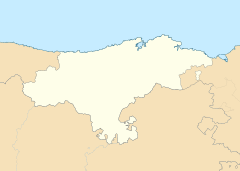Cueva del Valle | |
 Cave entrance | |
| Alternative name | La Viejarrona |
|---|---|
| Location | Rasines, Cantabria, Spain |
| Coordinates | 43°17′55″N3°25′10″W / 43.29861°N 3.41944°W |
| Type | Archaeological site |
| Length | 60 km (37.28 mi) |
| History | |
| Founded | c. 7000 BC |
| Periods | Upper Magdalenian |
| Associated with | Azilian |
| Site notes | |
| Discovered | 1905 |
| Excavation dates | 1905, 1996-1998 |
Cave del Valle (Spanish : Cueva del Valle, The Valley's Cave), locally also known as La Viejarrona (Old Girl), is located near El Cerro Village in the municipality of Rasines in Cantabria, northern Spain. [1] The cave is the source of the Silencio River, a tributary of the Rio Ruahermosa, which in turn is a tributary of the Asón River. Notable for its prehistoric, but particularly for its speleologic significance as it is recognized as one of the longest cavities in the world. The site is very popular among cavers, who have explored a total of over 60 km (37.28 mi) so far. [2]

